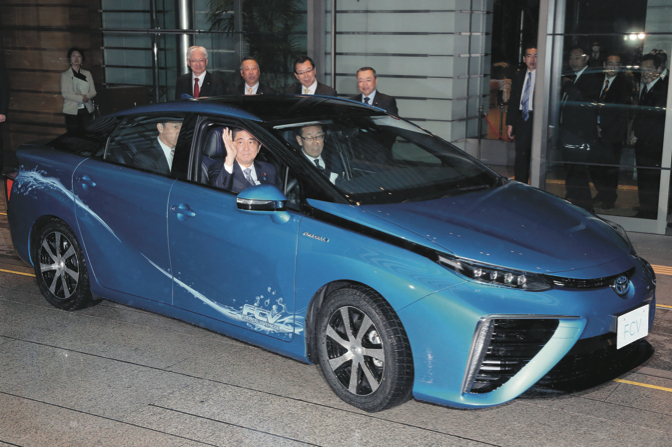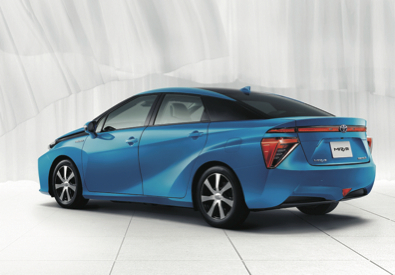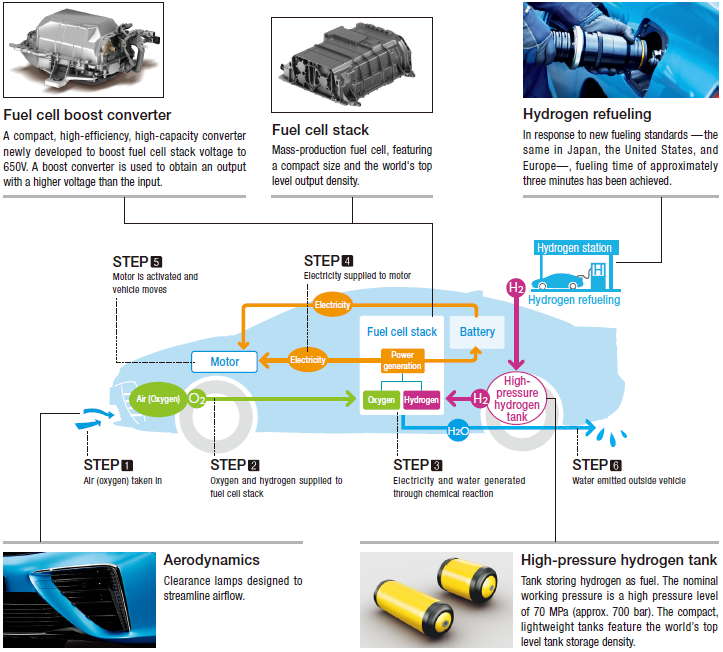The world’s first mass-produced fuel cell vehicle (FCV) went on sale in December 2014. It runs on hydrogen, takes only three minutes to refuel, and has a cruising range of 650 km (404 miles). It produces zero emissions and is more than twice as energy-efficient as gasoline-powered cars. The car has created quite a stir and has drawn attention from both within and outside of Japan. Using hydrogen as fuel—a promising, next-generation energy that is a virtually unlimited source of power—this ultimate eco-friendly car will no doubt dramatically change the over 100-year history of the gasoline engine. The future of the automobile for the next 100 years lies with the FCV.
Research and development for the FCV started in Japan in the early 1990s. It took over twenty years to reach commercial application. A representative from Toyota Motor Corporation, the company which is bringing the FCV to mass market, had the following to say, “In order to continue using cars, we have to overcome the fuel problem. Fossil fuels that we use today such as gasoline are a limited resource. And burning it emits CO², which causes global warming. Hydrogen energy can solve these problems in one stroke. That is why the hydrogen-powered FCV is being called the ideal eco-car.”
The FCV generates electricity by causing a chemical reaction between hydrogen and oxygen in a fuel cell. This electricity powers the motor that runs the car. The core technologies are the fuel cell and high-pressure hydrogen tanks. And through repeated rigorous testing, Toyota was able to improve performance and safety, and achieve a compact, low-cost solution.
“We’re an auto manufacturer so we have plenty of knowledge and experience of mechanics. But the core technology of this car is based on chemistry, so it really was unknown territory for us. Developing a car that would be the first of its kind was a worthwhile challenge,” continues the representative.
In addition to the core technology, Toyota also incorporated technology from its hybrid vehicles to reduce costs. Defying speculation that it would be impossible to price the car under JPY 100 million (USD 830,000), the sticker price has been set in the JPY 7 million plus range (USD 58,000 upwards). And an incentive for advanced vehicles offered by the Japanese government brings the price down to JPY 5 million plus range (USD 42,000 upwards). With such an affordable price, orders have been overwhelming. In the first month of its launch, Toyota has received orders for 1,500 cars. It is so popular that orders placed now will not be delivered until 2018.
But challenges still remain before FCVs become widespread. Even with its extended cruising range, there are not enough fueling stations to ease drivers’ worries of running out of fuel. Aiming to create an environment where people can easily refuel hydrogen fuel cells, the national and local governments are working together with energy companies and other corporations to build more hydrogen stations. Many people also wonder if hydrogen is safe or not. If more people understand that it is safe if used correctly, it will surely drive the spread of FCV.
The realization of the “hydrogen age,” the next energy revolution, is off to a running start in the tangible form of a car. And when the world sees the FCV on the streets of Tokyo during 2020 Tokyo Olympic and Paralympic Games, it will be a great way for Japan to promote its cutting-edge nextgeneration energy technology.
Prime Minister Shinzo Abe test drove the FCV and commented, “The car was very easy to drive, stylish, and good for the environment, and I believe it represents the start of a new era.”
The design on the side of the car going t o wards the back reflects flowing water being created from the air.

































































































































